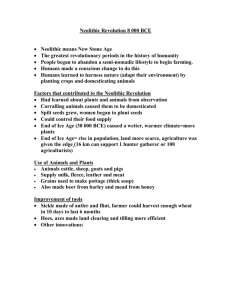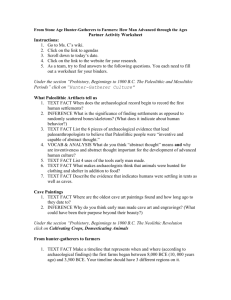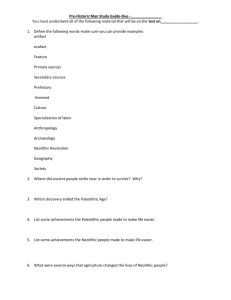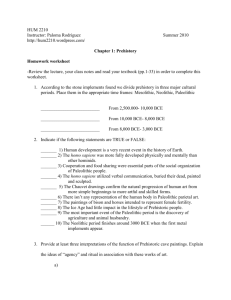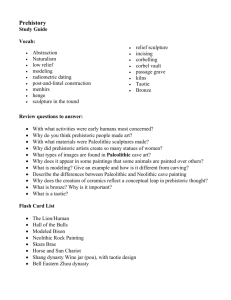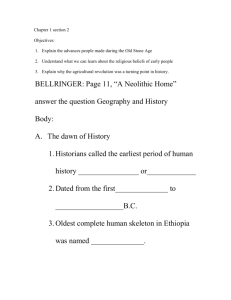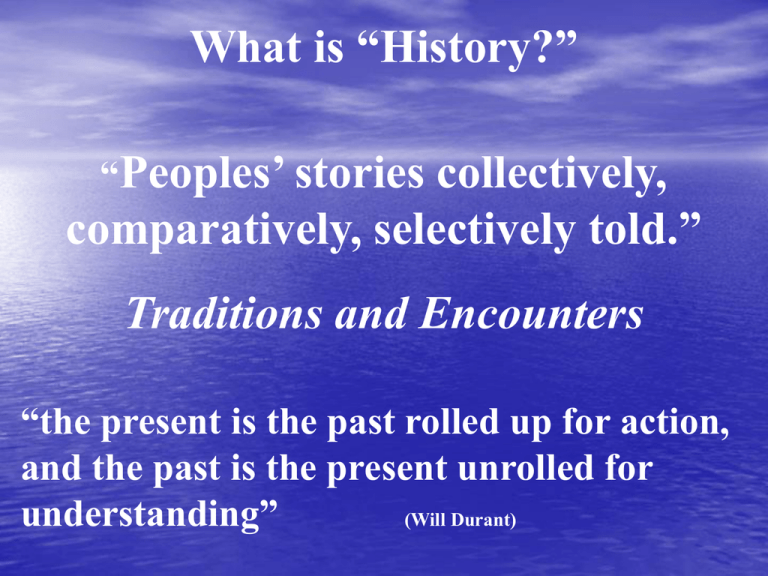
What is “History?”
“Peoples’ stories collectively,
comparatively, selectively told.”
Traditions and Encounters
“the present is the past rolled up for action,
and the past is the present unrolled for
understanding”
(Will Durant)
Tools of the Historian
• Documents
– Sacred history – myths, oral accounts
– Archaeological discovery – fossils, artifacts
– Written records- “recorded” (History)
– Scientific theory and evidence—evolution, DNA
and Carbon 14
• Human presence (or “natural” history) –
living communities, like the Kung
Tools of the Historian
• Time
– Chronology
• Cyclical vs. Linear
• BCE (Before the Common Era) – CE
(Common Era)
– Periodization (Prehistory/History)
• Categories of Time – Paleolithic, Neolithic
• Place – Geography and Maps
• Mercator Projection
• Peters Projection-T&E
MAPS
Can the way we picture the
world convey meaning—can
it be propaganda?
“it is clear that what happens on and
near Earth at the beginning of the
second cosmic year will depend very
much on the scientific wisdom and
the distinctively human sensitivity of
mankind”
Carl Sagan, The Dragons of Eden
The Question of Progress
• “There is no one inevitable path to
today’s world because it is impossible
to
characterize
today’s
world
simplistically. There always was and
is considerable variety among human
societies—though
this
may
be
decreasing, it is still there.”
• Agree or disagree?
Cover Slide
Objective I: The Emergence of Human Communities
Focus Questions:
What made humans human?
What can we learn from huntinggathering societies?
Why agriculture?
Gorilla
5-6 million
years ago
4
3
2
1
470,000
yrs.ago
125,000
yrs. ago
What does it mean to be
human?
• Genetically, humans are
97% the same as
chimpanzees, 96% the
same as gorillas
• Physical traits: bipedal,
opposable thumbs, larger
brains
• Intelligence
• Social and cultural
developments
• Relationship to our
environment
Hominid = “human-like species”
Fossilized footprints
What Made Humans Human?
Hominid Evolution: Three
Developments-Bipedalism
LUCY
-Larger Brain
-Voicebox
Fossilized footprints
Archaeologist Mary Leakey (shown at top of photo) found these
remarkable footprints of a hominid adult and child at Laetoli, Tanzania.
The pair had walked through fresh volcanic ash that solidified after
being buried by a new volcanic eruption. Dated to 3.5 million years
ago, the footprints are the oldest evidence of bipedalism yet found.
(SPL/Photo Researchers, Inc.)
Copyright © Houghton Mifflin Company. All rights reserved.
Well, if it isn’t the dawn of civilization!
“What about your precious opposable
thumbs now!?”
Perspective I: Human Biological
Evolution
LUCY
NEANDERTAL
http://www.becominghuman.org/
URUMCHI MUMMY
MIGRATIONS
• Out of Africa
• “We are all Africans under the skin.”
New York Times Headline:
Skull Supports Theory of Human Migration
By JOHN NOBLE WILFORD
Published: January 12, 2007
“The migrants appeared to have arrived
at their new homes in Asia and Europe
with the distinct and unmodified heads of
Africans.”
36,000 years old
Global spread of hominids and
Homo Sapiens
Why is homo sapiens the only
species of human today?
“The only good caveman is a dead caveman” –
aggression and war
“Make love not war” – reproductive and family units
“We ate them out of house and home” –
competition for available resources
“Together, wherever we go” – co-evolution of
language with know-how and sociability.
Saharan rock art
“Sympathetic Magic”
Saharan rock art
An unknown artist painted the dynamic scene of giraffes on a Saharan rock in what
is now Libya in 5000 B.C.E. This was from a rainy era when hunters could view
majestic herds of game. (Robert Estall Photography)
Copyright © Houghton Mifflin Company. All rights reserved.
What is the Paleolithic Era?
• “Old Stone Age”
• From the first hominid to approximately
7000 BCE
Characteristics of
Paleolithic
(Old Stone Age) Societies
•
•
•
•
•
•
Hunting and gathering (nomadic)
Isolation (Small bands)
Solidarity, equality and communalism
Gender roles
Limited specialization
Early religion: animism—worship of
humans and nature
Chauvet Cave
Chauvet Cave
On December 18, 1994, this cave in southern France was discovered by Jean-Marie Chauvet, a
French official. It contains the oldest and best preserved prehistoric cave paintings; more than
three hundred paintings were found of animals that inhabited the Stone Age world, including
panthers, cave bears, and mammoths. This black-painted panel in the Chauvet Cave shows
horses, rhinoceroses, and wild oxen. (Jean Clottes/Ministere de la Culture)
Copyright © Houghton Mifflin Company. All rights reserved.
Kung People
Humorous takes on
Paleolithic life…
Role of Women
• What roles did
•
women play?
Equality?
Mother Earth
“I still don’t see what harm could come from allowing
males to possess weapons.”
Why Agricultural
Revolutions?
“History followed different courses for different
people because of differences among peoples’
environments, not their biology.”
Jared Diamond
Myths about Farming
•
The first farmers made a conscious decision
to grow crops.
•
There is a sharp break between nomadic
hunting-gathering and farming.
•
Food producers manage the land more
actively than hunter-gatherers.
Why the Agricultural Transition?
The decline in the availability of wild foods.
The increase in the availability of domesticable wild plants.
The cumulative development of technologies on which farming
depends.
The two-way link between rise in human population and rise in
food production.
The greater advantages of farmers in the competition for
resources with hunter-gatherers.
“Agriculture is the great dividing line in human behavior” – Why?
Domesticated Plants
• There are 200,000 wild species
• 12 domesticated plants account for
80% of the tonnage of all crops
• Cereals: wheat, corn, barley, rice,
sorghum
• Pulses: soybean
• Tubers: potato, manioc, sweet potato
• Fruit: banana
Domesticated Animals
• 14 large mammals out of 148 possibilities!
• Big 5: Sheep, cow, goat
Pig, horse
• Camels, alpacas, llama
• Donkey, reindeer,
• Water buffalo, yak, Bali cattle and ox
Origins and early spread of
agriculture and pastoralism
Characteristics of Neolithic Societies
(New Stone Age)
How many of these are the result of
dependence on agriculture?
• Domestication of plants and animals required a
•
•
•
•
•
•
•
sedentary existence.
Population increases.
Food surpluses
New Technology
Specialization of occupations
New social institutions:
The neolithic village
The nomadic clan-tribe
Nomad-sedentary Conflict
Cities
100
90
80
70
60
50
40
30
20
10
0
Population (millions)
3000
BCE
2000
BCE
1000
BCE
500 BCE
Most agricultural civilizations were
patriarchal
Common attributes:
• Men dominate(d) economic, political, and
social life
• Men controll(ed) property and made all
decisions concerning families—including
marriage of children
• Marriage and inheritance were patrilineal
Pottery and Textiles
New Religious Beliefs –
Fertility Cults, the “Goddess”
Neolithic goddess
New Religious Beliefs –
Fertility Cults, the
“Goddess”
New attitudes towards Nature
Neolithic goddess
Many versions of a well-nourished pregnant female figure
were found in the Neolithic ruins of Catal Huyuk, a large
town in central Anatolia (modern Turkey). Here she is
supported by twin leopards whose tails curve over her
shoulders. To those who inhabited the city this figure likely
represented fertility and power over nature. (C.M. Dixon)
Copyright © Houghton Mifflin Company. All rights reserved.
Agriculture is NEW!
• The first hominids appeared 4 million
years ago
• People discovered agriculture only 9
thousand years ago
• 95 % of the time humans have inhabited
the earth, we have been hunter/gatherers

